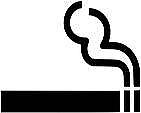 Smokeless tobacco Smokeless tobacco
JT launches Zerostyle Mint; New Style of Smokeless Tobacco Product
Japan Tobacco Inc. (JT) has launched of a new smokeless tobacco product;
Zerostyle Mint;
with sales beginning exclusively in Tokyo in mid-May 2010. The Zerostyle
Mint is a snuff
tobacco product. While the majority of consumers in Japan are smoking cigarettes,
this
product does not require a flame, and thus is smokeless, allowing consumers
use it in
the variety of places.
As conventional snuff products are relatively new to Japanese consumers,
the design
of the Zerostyle Mint was developed adopting a replaceable cartridge which contains tobacco
leaves. The product is fitted with a tapered mouthpiece and removable cap, and
consumers
can use the product for approximately half to one full day on a single
refill cartridge,
depending on the individual.
Source: Chris Lui, Tokyo, Mar 20, 2010 Japan Corporate News Network and
Japan Tobacco Inc.
What cancers are caused by or associated with smokeless tobacco use?
Smokeless tobacco users increase their risk for cancer of the oral cavity.
Oral-cancer can include cancer of the lip, tongue, cheeks, gums, and the
floor and roof of
the mouth. People who use oral snuff for a long time have a much greater
risk for cancer
of the cheek and gum than people who do not use smokeless tobacco. It contains 28
cancer-causing agents.
What are some of the other ways smokeless tobacco can harm users' health?
Some of the other effects of smokeless tobacco use include addiction to
nicotine, oral
leukoplakia (white mouth lesions that can become cancerous), gum disease,
and gum
recession (when the gum pulls away from the teeth). Possible increased
risks for heart
disease, diabetes, and reproductive problems are being studied.
Source: National Cancer Institute, U.S. National Institute of Health
The use of 'tobacco with no flame' in a debate on smoke-free spaces
Many restaurants, cafes, railway companies embarrassed for a new tobacco
product which
has no flame and no smoke. JT does not release a full detail of the toxic
substances which
was exhaled from a user of 'no-smoke tobacco'.
What is ' flame-less tobacco'? There are tobaccos of 'dip', 'snuff', 'plug',
'pinch' and 'spit'.
These are truly tobacco products and have the same adverse effect of ordinary
cigarette.
It has been reported that the smokeless tobacco contains 2.5 time nicotine
than that of
cigarette. The use of this kind of tobacco is very dangerous. The chew
tobacco and snuff
tobacco products will cause the throat or mouth cancer in the high incidence.
The major problem of this kind of tobacco is the adverse effect on the
health around the
user. When the user respirate, he or she may exhale all kinds of the tobacco
toxin. This is
entirely same to the situation of cigarette smoking. Therefore, the smokeless
tobacco
products should be forbidden in the enclosed public spaces.
The Japan tobacco Inc. trying to recommend to use this flame-less tobacco
in all spaces
in which smoking is banned. They intend to banish an anti-smoke law in
the world by
campaigning for no environmental adverse effect from the cigarette with
no flame.
However, JT admits there is a small amount toxic substance, that was exhaled
from
the user. They refuse to disclose their data.
No-flame, no-smoke tobacco may cause an oral cancer.
In a package of smokeless tobacco 'Zero Style Mint', a health warning is
printed as follows:
The use of snuff tobacco may cause the oral cancer, and the incidence of
heart attack
will increase. The use of this product may produce evil effects on a pregnant
woman,
causing the growth retardation of a fetus and a premature birth.
Japan Society for Tobacco Control submitted a document to the government
requesting
to ban a snuff tobacco product in the enclosed indoor space. For public
interests,
a carpet ban of smokeless tobacco at the smokefree restaurant, railway
train and aircraft
should be enforced by law.
Junhaku Miyamoto, MD,PhD, May 25, 2010
An Evil Action in 1998 by Japan Tobacco Inc.
An unreasonable demand by Japan Tobacco Inc. to withdraw the plan to ban
smoking inside of the aircraft cabin.
In September 1998, Japan Tobacco Inc. (JT) asked JAL, ANA to rethink smoking
ban
in the aircraft cabin. The tobacco company requested to change their airline
policy to
ban smoking on all international flights starting in the spring of 1999.
Mr. Mizuno, who is
the president of the formerly state-owned cigarette firm, JT asked JAL
to continue providing
some seats for passengers who want to smoke. He made the same request to
ANA, which
also announced smoking to be banned on its 47 international routes. ANA
officials said the
decision was prompted by the company's desire to follow the global trend
of restricting
smoking. JAL officials said the decision was based on results of an airline
survey that
showed some 80 percent of about 10,000 passengers felt the in-flight smoking
should be
banned. However, JT had strongly opposed smoking restriction and immediately
issued
a statement that said the nonsmoking measures would unfairly force smokers
to endure
hardships.
Smoking had earlier been banned on all flights of 22 foreign airlines using
Japanese airports.
Reference: Japan Times, Sept. 16, 1998
Japan Airlines allowed the use of smokeless tobacco at the aircraft cabin.
JAL announced to admit air passengers to use no-smoke tobacco in the airline
cabin.
This rule will apply to all international and domestic flights operated
by JAL group, said
a public relations Division of Japan Airline. The reason is that they believe
the words
of Japan Tobacco Inc., which states this tobacco is quite safe and no adverse
effects
to the passengers in the aircraft cabin.
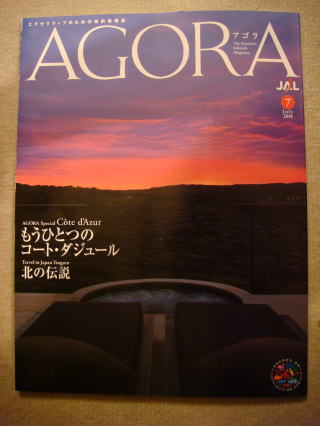 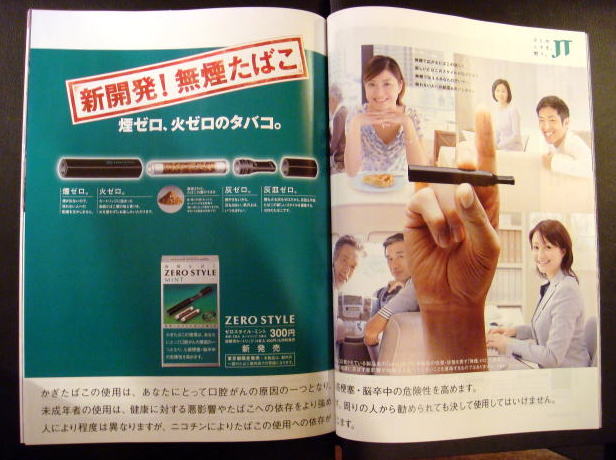
(L) The excutive lifestyle magazine issued by Japan Air Line, Jyly 2010.
日本航空発行の月刊誌
(R) The 40cm X 28cm size advertisement of 'smokeless tobacco' appeared
on the monthly magazine of JAL.
It says the pleasure life starts from the new style of tobacco. Your thoughtful
compassion
will extend to communicate through the smokeless tobacco with others who
do not smoke.
Comment 無煙たばこをサポートするJALと拒否するANA
The newly developed cigarette, smokeless tobacco, had a mixed reaction
among Japan's major
airlines. Japan Airlines (JAL) with a final difficulty, has given its credit
to use no-smoke tobacco
in the cabin. However, All Nippon Airways (ANA) has decided not to approve
the use of the
new cigarette, because it is a genuine tobacco and may cause adverse effects
on the passengers'
health.
In 1999, JAL banned smoking by passengers on international flights and
the other major airline
in Japan, ANA implemented a similar ban. These measure taken by the airlines
follow a recent
trend by North American and European carriers to curb smoking.
JAL, in January 2010, applied for court protection under the Corporate
Rehabilitation Law.
Shares of JAL were delisted in February 2010 from Tokyo Stock Exchange.
JAL is now
on the way of restructuring the company with the assistance of Japanese
Government.
Under these severe circumstances, JAL made a big mistake to accept no-smoke
tobacco
in the cabin. Their announcement was made at the almost same time, that
the tobacco
company started to sell no-smoke tobacco. Clearly, there was no evidence
that they verify
the adverse effect of cancer-causing materials, which we cannot overlook,
exhaled through
a smokers' breath into the air-tight cabin space.
ANA refused to accept no-smoke tobacco in their aircraft, to avoid any
bad effect to human
health. I believe that it is urgent to ban 'no-smoke tobacco' in the public
transportation.
Until then, when possible, although the incidence is almost negligible,
it is much safer and
comfortable to avoid the use of JAL aircraft.
Junhaku Miyamoto, MD,PhD, June 3, 2010
無煙タバコに口腔がんの危険性
無煙タバコ(Zero Style Mint、ゼロスタイル・ミント)が東京で発売となった。物珍しもあって
売れ行きは上々とのことである。タバコの煙が出ない, ゼロの文字があるから無害のような錯覚を
覚えるが、専用のカートリッジにはタバコの葉がぎっしり詰まっている。実際に商品を手にして、
パッケージを開けると強い異臭があり、ニコチン特有の頭痛を覚えるとのことだ。これは含有して
いるニコチンの量が多量であることに起因していると思われる。
商品の警告表示には「かぎタバコの使用は口腔がんの原因となり、心筋梗塞や脳卒中の危険性を
高めます」と記されている。さらに「妊娠中のタバコの使用は胎児の発育障害や早産の原因の一つ
となります」とある。今後の訴訟の場合を想定して、『「Zero」、「無煙」の表現は、本製品の
健康に及ぼす悪影響が他の製品に比し小さいことを意味しません』 と、有害物質をかぎタバコで
体内に取り入れても、それは本人の問題でタバコ会社は一切責任を負いませんと念を押している。
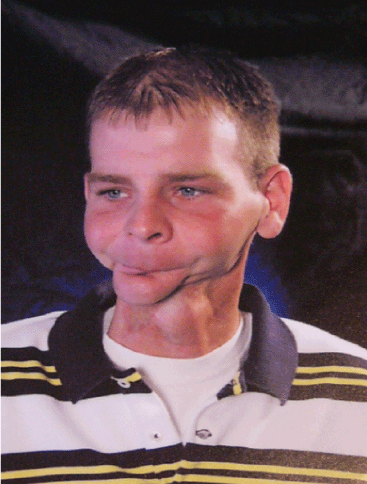 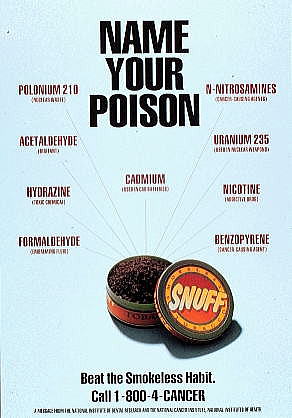
(L) He started smoking at age of 13, and found oral cancer at 17.
He had received operations for 30 times by the age of 25. He is now touring
U.S.,
campaigning for the very frightful experience brought by a tobacco use.
彼は13歳で無煙タバコを始め、17歳で口腔がんと診断された。現在25歳の彼はすでに30回の手術を
受けてかろうじて命を取り留めた。タバコの恐ろしさを広く知ってもらうため、自らの身をもって
全米各地を巡回している。
(R) A snuff tobacco contains 28 carcinogens, including the following poisons.
Polonium 210 (Nuclear waste ), uranium 235, N-Nitrosamines (Cancer-causing
agents), acetaldehyde, cadmium,
hydrazine, nicotine, formaldehyde, and benzopyrene (cancer-causing agent)
Source: The National Institute of Dental Research and the National Cancer
Institute, U.S. National Institute of Health
解説:ポロニューム210は元ロシア情報機関員リトビネンコ氏が殺害されたときに使用された猛毒の
放射性物質。ウラニューム235は核兵器の原料。ニトロサミンは発癌物質。アセタルデハイドは刺激剤。
カドミウムは電池製剤。ヒドラジンは毒物。ニコチンは依存性のある発癌物質。ホルムアルデヒドは
防腐剤。ベンゾフィレンは発癌物質。無煙タバコは上に示した28の発癌性物質を含んでいる。
口腔がんは転移が早く、顔が破壊されて行く悲惨な悪性腫瘍である。これから 無煙タバコを使用する
人で果たして何人の人がこうした危険性を認識しているだろうか。さらに深刻な問題はかぎタバコを
使用している本人でなく、周辺の人々に対する悪影響がある。無煙タバコ使用者から吐き出される
呼気にはニコチンを始め、たくさんの有害物質が含まれている。周囲の人々は知らないうちに毒性の
強い発癌物質や心臓血管収縮作用のある致死的危険にさらされることがある。
WHO指導で推し進められてきた世界規模の受動喫煙防止条例は喫煙者に禁煙のきっかけを作り
健康的な社会形成の助けとなって来た。それを「煙を出さない」とのキャチフレーズで、そうした禁煙へ
の動機、機会を奪い、ニコチンを安易に取り入れる環境を作ることによってタバコ依存症の人々を
増加させる憂うべき悪効果をもたらす。
事態を重視した日本禁煙学会では長妻厚生労働相らに対し無煙タバコの使用が周囲に及ぼす
悪影響(有害物質の呼出、臭気等)が強く懸念されるため、禁煙とされている室内空間での使用を
禁止するように要望した。

JAL ( Japan Airlines ) approved of the use of ' smoke-less tobacco' inside
an aircraft.
禁煙設定している飲食店、JRなどの交通機関では、その対応に苦慮している。現在は全くの
無法状態であるが、明確な方針を打ち出したのは日本航空(JAL)と全日本空輸(ANA)である。
JALは使用を容認、ANAはタバコであることには変わりないと、その使用を禁止した。
日本たばこ産業(JT)の目標はタバコ販売量の低下に結びつく受動喫煙防止法の弱体化に
あるのは明白だ。喫煙禁止した場所に、この無煙タバコを持ち込み、全面禁煙とした公共的
空間でニコチンを吸入する行為を正当化させようとしている。全面禁煙と設定したカフェ、
レストラン、電車、バスなどの輸送機関、航空機内部などがその対象だ。世界に空路を開設して
いる日本航空、JALは真っ先にそのターゲットとなっている。大幅赤字に苦しみ政府の財政
支援を受けている航空会社がJTの言うがまま、閉鎖空間での有害性を正しく検証することなく
無煙タバコに飛びついたのだ。
航空機内は密室状態である。無煙タバコ使用者の呼気から排出される有害物質は、たとえ
極小なものであっても絶対に認容すべきではない。それは大気中に放散される自動車の排気
ガスと全く異なる。日本政府が株式の50%を保有するJTに勧められるまま、喫煙者取り込みを
狙う日本航空は、やがてタバコを吸わない乗客の反感を買い、日航支持者や顧客を少しずつ
失って行くことも考えられる。
台湾、ハワイ、フランスなどの喫煙規制先進国では空港内の喫煙スペースを全廃している。
その理由は喫煙者同士が互いに傷つけ合う二次喫煙の問題と、喫煙室で吸いこんだ有害
微粒子が呼気で航空機内に排出され、また衣服、髪の毛などに付着残留して近隣の人に
悪影響を及ぼす三次喫煙を防止するためである。もし、あなたの隣にタバコ臭い、タバコの
臭いの染みついた喫煙者が座り、たとえ煙が出ないにせよ、喫煙する仕草をされたらどう
感じますか。人によっては我慢できず航空機内で小競り合いすることも必ずあり得ると思う。
健康障害はもとより、こうした不快な思いを避けたいならば、空の旅はやはり無煙タバコが
吸えないANAの利用しかない。
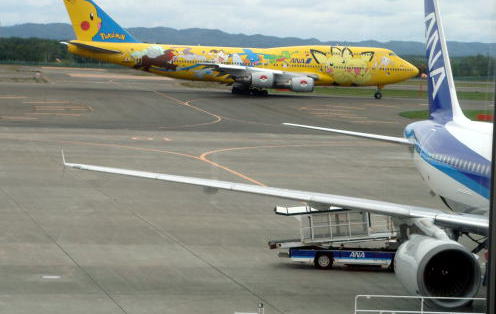
ANA ( All Nippon Airways ) disapproved of the use of ' smoke-less tobacco'
inside an aircraft.
Although Japan Air Line announced to admit air passengers to use no-smoke
tobacco
in the international and domestic airline cabin. How other airline companies
cope with this
health hazard problem, which also cannot neglect from the point of comfort
during of
the course of air travel.
The following is the policy of Airlines for the smokeless tobacco (no-smoke
tobacco):
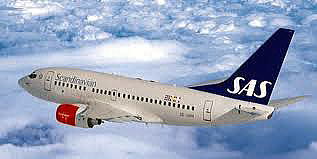 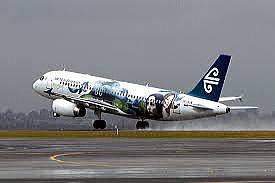 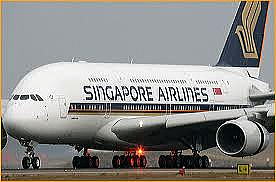
 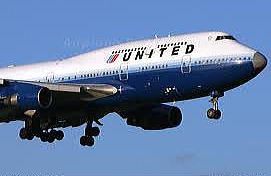 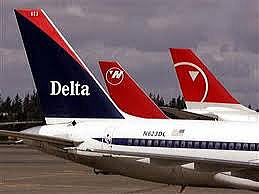
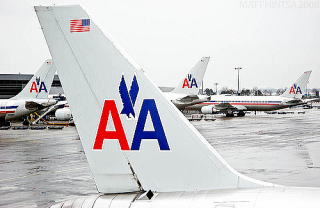 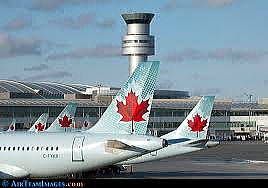 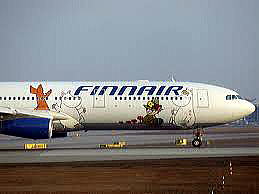
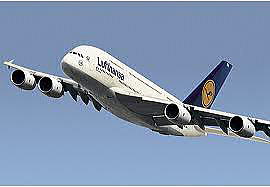 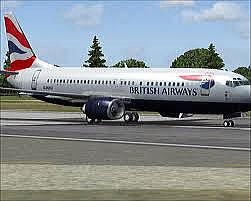 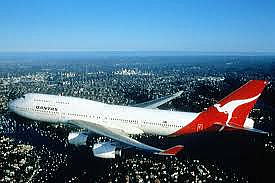
Qantas Airlines ( Australia ) refuse the use of smokeless tobacco.
Air New Zealand ( New Zealand ) refuses the use of smokeless tobacco.
Singapore Airlines ( Singapore ) refuse the use of smokeless tobacco.
China Eastern Airlines ( China ) refuse the use of smokeless tobacco.
United Airlines ( United States ) refuses the use of smokeless tobacco.
American Airlines ( United States ) refuses the use of smokeless tobacco.
Delta Air Lines ( United States ) refuses the use of smokeless tobacco.
Canadian Airlines ( Canada ) refuse the use of smokeless tobacco.
Scandinavian Airlines ( Denmark, Norway, Sweden ) refuse the use of smokeless tobacco.
The company allows the use of nicotine gum ( Snus ).
Finnair ( Finland ) refuses the use of smokeless tobacco.
Lufthansa ( Germany ) refuses the use of smokeless tobacco.
British Airways ( UK ) have no official decision at the time of July 2010.
However, there were a few cases that a passenger was refused the use of
smokeless
tobacco in the air cabin. No case has been reported the British Airway
allowed the use
of no-smoke tobacco.
The above data were directly obtained from the individual airlines, and
can be considered
as an official statement.
Reported by Junhaku Miyamoto, M.D., PhD. July 5 - July 12, 2010
日本航空ではタバコの煙が周囲にいる人に直接及ぶことがないので、空の旅の快適性が損なわ
れないとの誤認して「無煙たばこ」を受け入れたと見られる。しかし、JTの宣伝するような
「無煙タバコを介してタバコを吸わない人々との楽しいかかわり」などあり得るはずがない。
そこには受動喫煙防止の動きを封じ込めようとするタバコ会社の戦略があり、JALには喫煙客を
取り込みたいという狙いがある。しかし、一人の喫煙客を取り込めば二人のタバコを吸わない
乗客を失う可能性については全く考えていない。それは英国、北欧、北米、オセアニア諸国で
最近顕著になってきている喫煙行為そのものに対する嫌悪感だ。煙が出ないとはいえ、近くで
無煙たばこを吸っていたら、健康障害への不安感と共に、タバコを吸われることへの不快感を
著しく増幅させ、快適な空の旅は台無しとなるからだ。
日本航空を除く世界の代表的航空会社は、「無煙タバコ」の機内使用に対し、はっきりと
NO!を突きつけている。
No more 'smokers- friendly' Japan Airlines
日本航空が世界から「タバコ容認のエアライン」の汚名を浴びないよう、快適な空の旅を楽しめるように、
無煙たばこの航空機内禁止を要望しよう。⇒ 今は、世界の航空会社と同じ、航空機内全面禁煙に転換している。
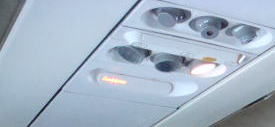
今回、日本航空の国内線と国際線に乗って無煙タバコが実際に日航機内で使用されているか否かの
実態調査を行った。今回いずれの搭乗予約は日航が無煙タバコの機内使用を認め、3ヶ月前の2月に
行っていた。もし、無煙タバコの機内承認の後であったら日本航空でなく、全日空を利用したと思う。
自らの「健康に少しでも悪影響を及ぼす航空会社」を回避するためだ。
2010年9月に利用した羽田ー松山間の航空機内では誰一人無煙タバコを吸っているのを見かけ
なかった。同乗のスチワデス2名について、別々に「無煙タバコを吸っているのを見かけなかった
かどうか問いただしたところ「NO」の返事が戻ってきた。9月から10月にかけて成田ーシカゴの
国際線にも搭乗した。往復の機内です客室乗務員に同じ質問を繰り返した。シカゴ行きの機内
では 6,7人いたスチュワデスの中で一人から無煙タバコを乗客を数人見たとの答えが戻ってきた。
他の乗務員は全員、5月の発売以来、一度も見たことがないとのことであった。成田への帰路、
無煙タバコをい吸っている人を見たとのスチュワデスに話を聞いた。そのときは電子タバコと無煙
タバコの違いがはっきりしていない様子もあったが、無煙タバコなので害はないと思っていたので
(隣席の乗客に)心配ありませんと話したようだ。筆者は顔の変形をもたらす口腔癌の発癌性が
高いこと、喫煙者の吐く息から有害物質が機内に拡散することをを話したら乗務員の顔色が
青ざめた。無煙タバコは完全に無害だと信じていたからだ。
実際に日本航空を利用して無煙タバコはほとんど使用されていないことが判明した。しかし、客室
乗務員にその深刻な有害性は知らされてはいない。仕事として頻繁に日航機内で勤務を重ねることに
なれば真っ先に客室乗務員がその犠牲者となるであろう。「新しいことに挑戦して得意がる変わり者」
が少ない今のうちに、航空機内での全面禁煙を実行すべきである。その判断が遅くなればなるほど、
自体は複雑化し海外でのの日本航空への信頼は徐々に低下、その信用を失墜するであろう。
今回の旅行には、アメリカン航空、ユナイテット航空も利用したが、無煙タバコの使用を禁止して
いるため、何の不安感もなく快適な空の旅を過ごすことが出来た。
ANA MILEAGE CLUBに入会
今までJAL MILEAGE CLUB 会員として専ら日本航空を利用してきたが、会社の無煙タバコ機内
使用承認を機に、健康を守りたいとの気持ちから無煙タバコを禁止しているANA の利用を始める。
今年、2011年1月にANA MILEAGE CLUB に入会した。日本航空が今後も無煙タバコの使用を
認める限り他の航空会社の積極的利用も進めて行きたい。
JALスタッフの現場応対、電話対応などに職員の誠意ある態度が反映されていることが多い。
ここで昔の栄光を蘇らせるために鶴の日航マークを復活させるという。しかし、乗客の健康を守る
視点では世界最低の航空会社の一つとして位置づけられていることを、会社のトップは気付いて
いるのだろうか。
The writer became a member of the ANA Mileage Club, Star Alliance, to avoid
a health hazard
caused from no-smoke tobacco, which is admitted to using in the aircraft
cabin of Japan Air Lines.
今回も成田からパリに向かう日本航空機内でスチュワデスに「無煙タバコ」の使用者を見たことがある
か否かを聞いてみた。答えは「全くない」であった。事の次第は異なるが、沖縄便でトイレの中で吸った
乗客があり機長アナウンスで注意を呼びかけたことはあったそうだ。前回のシカゴ便といい、日本航空
内で「無煙タバコ」を吸う人は皆無に近い。それなのになぜ「無煙タバコ」の機内使用をアピ−ルし、
世界の旅行客の顰蹙を買うのか、その真意が分からない。馬鹿げたことは即刻止め、日本航空の信用
を高める方が遙かに得策なことも、社長を始め幹部連は理解するだけの頭脳を持ち合わせていないの
だろうか。
Almost all flight attendants in JAL had no experience to see a passenger
who uses no-smoke
tobacco in an air-cabin. I wonder why JAL admitted using a tobacco product
inside of the
aircraft. There would be no merit for the company. It harms and loses the
credit of JAL. Some
health-conscious passenger may rather use other competing airlines to avoid
the risk.
I recommend JAL to prohibit the use of no-smoke tobacco in an airtight chamber as soon as
possible for the own company and a client.
Junhaku Miyamoto, M.D.,PhD
 Topics 喫煙の客に憤り 空港へ折り返す Topics 喫煙の客に憤り 空港へ折り返す
台北からマカオに向かっていたマカオ航空の定期便で1月、乗務員の忠告を聞かず座席で2度にわたり
喫煙した乗客に憤った機長が決断し、台北空港に戻るという珍事が起こった。乗客は航空警察に引き渡され、
取り調べを受けた。この乗客は台湾籍の男性。飛行機は離陸から20分を超えていたが、機長の判断で
台北空港にUターンした。男性は民用航空法違反で取り調べを受け、煙害防止法にも抵触しているため、
県衛生局からも罰金刑が科せられる。機内での喫煙は1万台湾元(3.2万円)から5万元(16万円)の罰金。
煙害防止法に違反するとさらに2000元から10000元の罰金が科せられる。他の乗客もこの乗客の傲慢
(ごうまん)な態度には憤っており、機長の判断に賛同を示した。
引用:中国時報(台湾)、2013年2月4日
/////////////////////////////////////////////////////////////////////////////////////////////////////////////////////////////////////////////////////////////////////////////////////////////////////////
Smoking Ban in Airports
 Malta Malta  Ireland Ireland 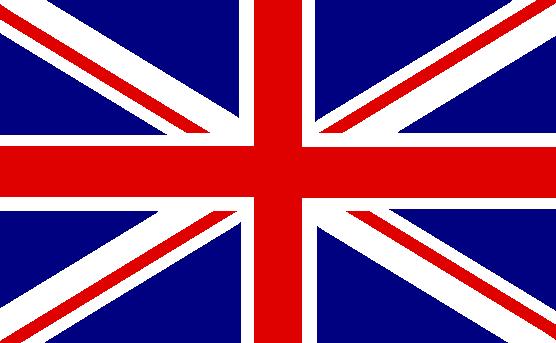 North Ireland North Ireland  London London 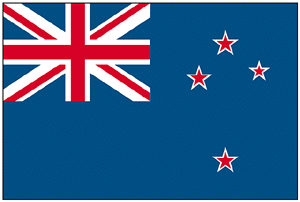 New Zealand-Christchurch New Zealand-Christchurch  New Zealand-Auckland New Zealand-Auckland
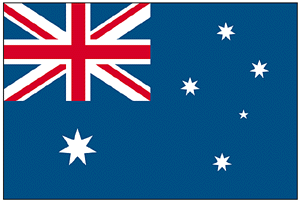 Australia Australia  Montreal Montreal  Vancouver Vancouver  Calgary Calgary  Boston Boston  New York New York 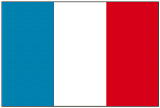 France-Paris France-Paris
 Finland-Helsinki Finland-Helsinki  Iceland Iceland Guam Guam  Chicago Chicago  Miami Miami  Hawaii Hawaii  Bangkok Bangkok
 Taiwan Taiwan  Bhutan-Paro Bhutan-Paro  Spain Spain  Portugal Portugal  Netherlands Netherlands 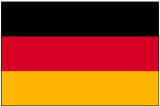 Berlin Berlin
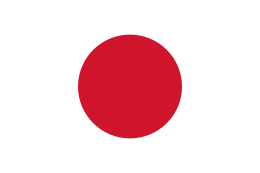 Haneda Haneda  Sapporo Sapporo  Narita Narita
//////////////////////////////////////////////////////////////////////////////////////////////////////////////////////////////////////////////////////////////////////////////////////////////////////////
 「無煙タバコ」の機内使用 「無煙タバコ」の機内使用
 2010年5月執筆 2010年7月加筆 2010年10月加筆 2011年1月加筆 2011年6月加筆 2013年2月加筆 医学博士 宮本順伯 2010年5月執筆 2010年7月加筆 2010年10月加筆 2011年1月加筆 2011年6月加筆 2013年2月加筆 医学博士 宮本順伯
掲載写真および記事の著作権は宮本順伯に帰属
★このサイトへのリンクは自由
The article was written in May 2010, and last revised in February 2013,
by Junhaku Miyamoto, M.D., PhD.
Copyright (C) 2010 Junhaku Miyamoto, PhD. All right is reserved.
|
Twitter@worldviewtokyo
Twitter@smokefreejpn
Twitter@criticismjpn